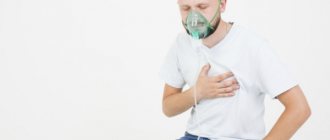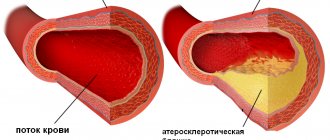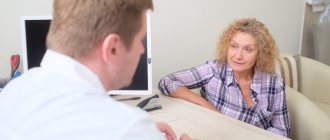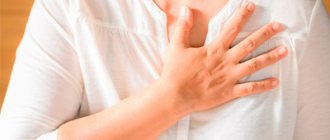This information explains how to relieve shortness of breath.
Sometimes you may find it difficult to breathe and feel like you are out of breath. This condition is called shortness of breath or dyspnea. Shortness of breath may be caused by:
- damage to the lungs due to cancer or its treatment;
- blood clots in the lungs (pulmonary embolism);
- fluid around the heart or lungs;
- pneumonia (pneumonia);
- asthma or emphysema;
- heart damage (chronic heart failure);
- anemia (low levels of red blood cells in the body).
Depending on the cause, shortness of breath may be transient or permanent.
to come back to the beginning
Relief of shortness of breath
The best way to relieve shortness of breath is to treat the cause. But this is not always possible. Your doctor and nurse will work with you to determine the best ways to improve your breathing. Below are other ways to relieve symptoms.
General Tips
- Try using a small hand-held fan to blow air on your face when you feel out of breath. This is a way to provide immediate relief from shortness of breath.
- When carrying out daily activities, limit your activity so as not to cause discomfort. If you are out of breath, stop and rest until your breathing is the same as when you started your activity. After that, get back to what you're doing if you can.
Oxygen
Every cell in your body needs oxygen. If your blood oxygen levels are low, you may experience shortness of breath. Your doctor or nurse can measure the oxygen levels in your blood using a small finger-worn device called an oximeter.
If you don't have enough oxygen in your blood, breathing in extra oxygen can help make you feel better. You can get extra oxygen in two ways:
- Using a hub. A concentrator is a small machine that takes oxygen from the air and delivers it to you through a thin, flexible tube placed under your nose.
- From a portable oxygen cylinder. You can take this cylinder with you anywhere. If the oxygen in the cylinder runs out, it can be refilled. Companies that provide breathing machines or home care services can deliver oxygen to your home if needed.
Medicines
Your doctor may also prescribe medications for shortness of breath, depending on the cause. You may take these medications by inhalation, orally (by mouth), or intravenously (through a vein).
- If you have asthma, emphysema, or chronic bronchitis, your doctor may prescribe a nebulizer or inhaler. Both devices spray the medication into tiny droplets that you inhale. Your nurse will teach you how to use a nebulizer or inhaler.
- If you have a blood clot in your lung, your doctor may prescribe a blood thinner (anticoagulant). This medicine may be taken as a tablet or as an injection (shot). Your doctor will order blood tests and tell you what precautions you need to take while taking these medications.
- If you have pneumonia, your doctor may prescribe antibiotics to treat it.
- If you have too much fluid around your heart or in your lungs, your doctor may prescribe medications such as diuretics (water pills) or diuretic injections to get rid of the fluid.
Other medications that may help make breathing easier include:
- corticosteroids, such as prednisone (Deltasone®) or methylprednisolone (Medrol®);
- pain medications such as morphine sulfate (Avinza® or Kadian®).
Your doctor will discuss with you which of these medications is best for you.
to come back to the beginning
Diagnostic stages
- Consultation with a therapist. The doctor will conduct a thorough examination of the patient and ask him about accompanying symptoms. If necessary, he will refer the patient to other specialists at our hospital - cardiologists, hematologists, psychotherapists.
- Laboratory diagnostics: general blood test;
- general urine analysis
- spirography
Breathing exercises
Your nurse can show you how to take slow, deep breaths to help relieve shortness of breath. You can do them with the diaphragm, the muscle that separates the chest cavity from the abdominal cavity (see Figure 1). This type of breathing is called diaphragmatic breathing.
Figure 1. Aperture
Try to relax while doing breathing exercises. Relieve muscle tension. This will allow the abdominal cavity (belly), chest, and lungs to expand.
Here are some breathing exercises that can help relieve shortness of breath.
Deep breathing 4-8-8
This exercise improves the movement of air in the lungs. This helps increase oxygen levels throughout the body.
- Inhale through your nose, counting to 4.
- Hold your breath and count to 8.
- Exhale through pursed lips (as if you were whistling) for a count of 8.
- Repeat 4 times.
Chest wall stretch
This exercise will help the chest muscles become more elastic.
- Inhale through your nose, counting to 4. As you inhale, extend your arms in front of you and raise them above your head.
- Exhale through pursed lips. As you exhale, open your palms and lower your arms down to your sides.
- Repeat 4 times.
Rapid breathing through the nose
This exercise can help strengthen your diaphragm.
- Shut your mouth.
- Inhale and exhale quickly through your nose for 15 to 30 seconds.
- Practice this exercise several times until you can do it for 60 seconds.
Walking and breathing
These tips will help you breathe easier when walking.
- When walking on a level surface, inhale and exhale through your nose without opening your mouth.
- On inclined surfaces (slopes), inhale through your nose and exhale through pursed lips.
- When climbing stairs, exhale at each step through pursed lips.
Recovery from an attack of shortness of breath (from coughing or exercise)
- Tuck your chin to your chest.
- Take 10 short and sharp exhalations through your mouth. If necessary, take short breaths between them.
- When your neck muscles relax a little, inhale through your nose.
- Exhale 3 times through pursed lips. Inhale between exhalations.
- Inhale through your nose, counting to 4.
- Exhale through your open mouth, counting to 8 and making the sound “ah”.
- Repeat 3 times.
to come back to the beginning
Symptoms of pathology
With difficulty breathing, the patient cannot take a deep breath. He makes at least 22 breathing movements per minute. This is typical for moderate pneumonia. In severe cases of the disease, the number of inhalations and exhalations per minute exceeds 30.
A severe inflammatory process is recorded in the lung tissues. A person’s body temperature rises and a nonproductive dry cough occurs. It also happens that there are no accompanying symptoms. Then we can assume that shortness of breath is caused by panic attacks, psychosomatics, and fear.
If, when listening to the lungs, the doctor hears wheezing or whistling, it means there is coronavirus pneumonia and the bronchi are affected. This clinical picture is often observed in individuals with concomitant bronchitis, bronchial asthma, and secondary bacterial infection. It often precedes pulmonary edema.
Difficulties with breathing after coronavirus can be described as follows:
- feeling of tightness in the chest;
- rapid breathing;
- performing shallow breathing movements;
- heaviness when trying to take a deep breath.
Shortness of breath in itself is not a disorder in healthy people. Runners and athletes encounter it. If the onset of the symptom was preceded by difficult physical work, then shortness of breath is the norm. During and after coronavirus, the problem manifests itself even at rest. And this is a dangerous sign. It indicates that the body is suffering due to oxygen deficiency. As you know, in conditions of oxygen deficiency, not a single internal organ works fully.
Relief from anxiety
Shortness of breath can cause feelings of fear. Some people say they feel anxious when they start to feel short of breath. However, anxiety can make breathing even more difficult.
Breathing exercises from this material can help you relax. You may also want to know other ways to help relieve anxiety. Talk to your doctor about any anxiety you have. He may prescribe anti-anxiety medications such as alprazolam (Xanax®) or lorazepam (Ativan®) to help you.
Our Integrative Medicine Service also offers relaxation programs that may be beneficial for you.
to come back to the beginning
Causes of development of chronic heart failure
Chronic heart failure can develop in patients suffering from coronary heart disease, arterial hypertension, and heart defects. In coronary heart disease, a common cause of left ventricular systolic dysfunction and chronic heart failure is acute myocardial infarction and ischemic cardiomyopathy. The progression of chronic heart failure is caused by changes in the geometry and local contractility of the heart muscle.
In patients suffering from hypertension, regardless of the cause of arterial hypertension, a structural restructuring of the myocardium occurs, which is called a “hypertensive heart”. Chronic heart failure develops as a result of acquired and uncorrected rheumatic defects. Other causes of chronic heart failure include infective endocarditis, toxic cardiomyopathy due to exposure to drugs, alcohol, radiation therapy, systemic vasculitis, metabolic and endocrine disorders.
Ways to improve lung function on your own
What can a person suffering from shortness of breath after coronavirus do? There are simple ways to normalize pulmonary activity:
- Eating foods that increase lung capacity. Preference should be given to fruits and vegetables. Tomatoes, blueberries, nuts, onions, and citrus fruits are especially useful. Spices and fatty foods should be avoided.
- No smoking. Tobacco smoke and the toxins it contains make the lungs extremely vulnerable. In order for the tissue to recover and the inflammatory process to stop progressing, it is important to stop smoking.
- Do cardio workouts. You need to start them only if you are in good physical health. Cardio increases lung capacity, normalizes blood circulation, and increases heart rate. It is good if the exercises are performed in the fresh air. But the load should be increased gradually.
- Respiratory protection from environmental pollution. A person who has recently had Covid-19 should not be in polluted conditions. If his professional activity involves being in harmful conditions, it is better to take a long vacation.
Patients who strictly follow the doctor's instructions, take medications, perform breathing exercises and eat properly quickly stop suffering from shortness of breath. Take care of your health and don't let the coronavirus deprive you of your ability to breathe deeply.
Literature:
- COVID-19, coronavirus infection caused by SARS-CoV-2 / 2020 / ORGZDRAV: News. Opinions. Education. VSHOUZ Bulletin.
- COVID-19: respiratory infection caused by a new coronavirus: new data on epidemiology, clinical course, patient management.
- Medical rehabilitation for new coronavirus infection (Covid-19) / Ivanova G. E., Balandina I. N., Bakhtina I. S., Belkin A. A., Belyaev A. F., et al. / 2021 / Physical and rehabilitation medicine, medical rehabilitation
The text was checked by expert doctors: Head of the socio-psychological service of the Alkoklinik MC, psychologist Yu.P. Baranova, L.A. Serova, a psychiatrist-narcologist.
CAN'T FIND THE ANSWER?
Consult a specialist
Or call: +7 (495) 798-30-80
Call! We work around the clock!









